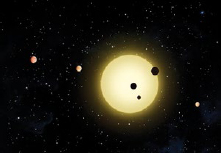2009
Kepler Mission
Around the turn of the twenty-first century, astronomers began perfecting and testing a variety of techniques for detecting extrasolar planets. The most common search method—radial velocity surveys—is most sensitive to giant (Jupiter-size) planets orbiting close in to their parent stars. Indeed, those kinds of (likely inhospitable) extrasolar planets have been overwhelmingly among the first to be discovered. Other methods can identify smaller, even Earth-size planets around other stars, but some of them, like pulsar measurements and Gravitational Lensing, require either exotic environments likely inhospitable for life or one-time events that don’t allow the detected planets to be further characterized.
Perhaps the most promising way to detect Earth-size planets in the neighborhood around their stars is to rely on luck: if the geometry is just right, such planets will occasionally pass in front of or transit their parent stars, dimming those stars’ light by a tiny but detectable amount and in a predictable, periodic way. Finding Earth-size worlds that way is the goal of NASA’s Kepler mission, named in honor of the Renaissance astronomer Johannes Kepler, discoverer of the fundamental Laws of Planetary Motion.
The Kepler satellite was launched in 2009 into an Earth-trailing solar orbit to conduct a simple mission: stare at 145,000 nearby main sequence stars for three and a half years and monitor their light to search for periodic planetary transits. Kepler’s 42 charge-couple device (CCD) detectors form the largest camera (95 megapixels) ever launched into space, sensitive enough to detect changes in starlight as small as 0.004 percent, or 1 part in 25,000.

Artist’s rendering of planets discovered around Kepler-11; six planets transit that Sun-like star.
The results from Kepler’s 2009–2013 prime mission are stunning: more than 2,500 planets have been confirmed around nearby Sunlike stars, and nearly 5,000 more are awaiting confirmation by other astronomical methods. Many of those are “hot Jupiters” in rapid, close-in orbits. However, more than 50 could be Earth-sized planets in the habitable zone around their host stars. In late 2013, Kepler began an extended mission, called K2, designed to find extrasolar planets in more regions of the sky and to study other astronomical objects.
SEE ALSO Astronomy Goes Digital (1969), First Extrasolar Planets (1992), Planets Around Other Suns (1995), Habitable Super Earths? (2007), Planets Around TRAPPIST-1 (2017).
Artist’s rendering of NASA’s Kepler Space Telescope, which hunts for planets orbiting other nearby Sun-like stars. The telescope monitors stars within the six parts of the sky depicted here, along the ecliptic (Earth’s orbital path around the Sun).
